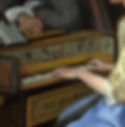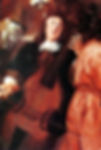Early Baroque composers
- Naomi Leila🌸
- Mar 3, 2021
- 5 min read
Updated: Mar 4, 2021

The Baroque period spanned from around 1600 to 1750. The term Baroque was derived from the Portuguese word, 'Barroco' which means, 'oddly shaped pearl'. The Baroque period was a time where the wealth and power was mainly possessed by the noble class, which meant that there was less power given to churches. This enabled non-religious, instrumental music to flourish, which led to many new forms of music to arise including; the 'concerto grosso' (solo instruments accompanied by an orchestra), Cantatas (sung pieces for church), Sonatas (sounded pieces for a solo instrument and accompaniment) and the suite (dance inspired movements which often started with overtures). The newly introduced form Opera was also greatly developed during this period. It was a time of discovery and rules, with an emergence of more modern harmonies. The objective of the composers at this time was to affect the listener's emotions.

Typical characteristics of Baroque music include:
1. writing long flowing melodies that often included ornamentation (trills & turns)
2. using terraced dynamics (sudden changes in volume)
3. contrasting solo and ensemble playing.
4. contrapuntal textures
5. Use of the basso continuo (harpsichord + cello, bass, or bassoon) and upper strings (violin & viola).
6. Emphasis on the solo voice to create a polarity between the melody and bass line.
The lute and viol continued to be used and the string instruments, like the violin, used gut strings (as opposed to metal strings that we use today) this created a softer and sweeter tone to the music. During this time, the first version of the modern orchestra was created, as they started to group the instruments together in more standard ways.
The Early Baroque period spanned from around 1600-1640. During this time words were set to music more clearly and there was more use of homophonic textures, dissonances and contrasts between sounds e.g. loud vs. soft and chorus vs. solo.
Famous composers from this period include; Jean Baptiste Lully and Dietrich Buxtehude.

Jean-Baptiste Lully: 1632-1687 Italian-born French composer, instrumentalist, and dancer
Brief History: Born Giovanni Battista Lulli in Florence to a father, of peasant stock and a miller's daughter. It's assumed he was taken to France by the Duke de Guise where he changed his name to Jean-Baptiste Lully. Upon arriving he became a member of Mademoiselle de Montpensier's string ensemble and then was dismissed for composing some scandalous verses. In 1652 he joined Louis XIV, the sun king's court violin ensemble, then quickly ascended to hold royal appointments as music composer to the king and as music master to the royal family. He spent most of his life working there and composed music for the court ballets, collaborated with Molière (famous french playwright) and from 1672 until his death he was in charge of the, 'Academie royale de la musique et de la danse' and worked with the librettist Philippe Quinault on operatic and ballet works. He died in Paris.
Musical Style: From 1662 he completely controlled French court music. His style was copied throughout Europe. He was a pioneer who introduced new dance music including; the minuet, bourrée, gavotte and gigue. He mainly used French texts for his works and he his operas were often highly dramatic and theatrical, described as "tragedies set to music".
Fun Facts:
He danced with Louis XIV and Pierre Beauchamp and was responsible for the first ballet starring a female, Mademoiselle Lafontaine, who was admired for her elegant style (when she retired she became a nun).
Molière pocketed most of the money for their collaborations so Lully ceased working with him.
From 1674 no opera could be performed anywhere in France without Lully's permission, as he obtained the patents of operatic production from Pierre Perrin and Robert Cambert.
In 1681 he received his 'lettres de nationalisation' and his 'lettres de noblesse'. He also became one of the secrétaires du roi, a privilege usually held only by the French aristocracy.
While conducting Lully often tapped the beat with a pointed ballet master’s cane. During a performance of his TeDeum, in the winter of 1686-87 he jabbed his foot with the cane and wounded himself. The wound became infected, gangrene set in, spread to his leg and he died 3 months later.
Music Recommendations: Les ballets du roi: Gavotte en rondeau (arr. for violin and piano) &

Dietrich Buxtehude: 1637-1707 Danish-German organist and composer of church music
Brief History: Buxtehude's place of birth and nationality are disputed. It is however now recognised that he most probably was born in Helsingborg, Skåne (part of Denmark at that time) as Buxtehude recognised Denmark as his native country. Not a lot is known about his youth but as his father was an organist at Helsingborg it is thought that he probably learnt his craft from him. In 1657-58 he was an organist at Helsingborg. In 1660-1668 he was the organist at Elsinore (Helsingør). And in 1668 he settled in Lübeck where he became the organist at St. Mary's Church and married his predecessor's (Franz Tunder) daughter. His brother and father both joined him there and he held that position for the rest of his life until he died there in 1707. He gained a great deal of fame in Lübeck attracting many composers there with his musical soirées known as "Abendmusik" (evening music). Abendmusik remained a feature of the church until 1810.
Musical Style: Most of his music was lost and remains lost, though some has been recovered in the 20th century. He composed works for public festivals, marriages and funerals in both instrumental and vocal styles. His most influential works were his compositions for the organ which include, toccatas, preludes, fugues, chaconnes, pieces based on chorales, and a passacaglia. All of his pieces had a devout style.
Fun Facts:
His music influenced many later Baroque composers, including Bach, Handel and Telemann.
Bach and Handel both traveled to Lübeck to meet Buxtehude and hear his music. Handel went there in 1703 and Bach walked 250 miles there to meet him in 1705. Buxtehude was ready to retire and impressed by both Handel and Bach's skills. He offered them both his position at Lübeck but they declined not agreeing to the condition of the post, to marry his eldest daughter, Anna Margareta.
Music Recommendation: Sonata in A-Moll, BuxWV 272: III. Passacaglia & Cantate, BuxWV 15: Alleluia
I hope you enjoyed this post. Remember If it's Baroque don't fix it!
Much Love
Naomi Leila Xx
P.s. Watch out for my next blog instalment on Middle Baroque composers.
P.p.s. This work is mainly from a lot of research I've done on the internet. If anything is inaccurate please let me know and I will update it.
P.p.p.s If you are looking to delve more into the characteristics of the Baroque period this is an amazing resource on it: https://www.unatego.org/Downloads/Baroque%20Era%20(MA).pdf
P.p.p.p.s If you liked this please press the heart button and become a member to never miss a post :)








